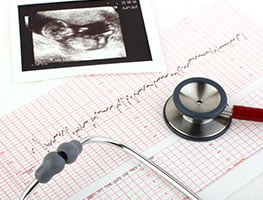A normal or average fluid volume is around 500-1,000 ml (1 litre). When the volume exceeds two litres, then it tends to become noticeable, primarily to the mother because of her increasing discomfort. Polyhydramnios occurs in around 1% of pregnancies.
In the majority of cases polyhydramnios is not a problem. The brief period of time where normal fluid production is out of synchrony soon stabilises and the extra fluid is reabsorbed by the mother’s body.
Where does Amniotic Fluid come from?
Amniotic fluid is produced by the baby’s kidneys. There is a constant cycling and recycling of fluid into and out of the baby’s lungs and stomach. As the fluid is digested, it is then excreted by the baby’s kidneys only to be recycled again. In cases where the amniotic fluid volume stays high and does not correct itself, a problem with the baby is suspected.
Mothers who develop polyhydramnios are closely monitored for complications. Occasionally there are developmental problems with the baby, specifically impairment of their swallowing or their ability to absorb the fluid. Conditions involving the small intestine, oesophagus, stomach and diaphragm can all lead to polyhydramnios developing. Another reason it develops is if the baby has neurological problems or complications with their central nervous system.
Other Risk Factors for Developing Polyhydramnios
-
Mothers who are carrying multiple babies. This is because of the size of the placenta and the amount of space it occupies in her womb.
-
Mothers with gestational diabetes, which is not being treated effectively.
-
When identical twins are present and they have developed twin-to-twin transfusion. This is a condition that can arise when one baby is receiving more blood flow than the other.
-
In many cases, the cause for polyhydramnios is unknown.
Risks of Polyhydramnios
The earlier in pregnancy that polyhydramnios is diagnosed and the greater the volume of amniotic fluid, the more risk of complications developing.
-
Premature delivery of the baby (due to premature rupture of the membranes)
-
Placental abruption
-
Cord prolapse
-
Need for a caesarean section delivery and the additional complications of this versus a normal vaginal delivery
-
A higher chance of post-delivery bleeding i.e. postpartum haemorrhage, because the womb has less muscle tone and cannot contract down as fully as it needs to
-
Having a baby that is larger than the normal size
-
Stillbirth
In the majority of cases of polyhydramnios, there are no complications. As soon as the baby is born, the excess fluid drains away and the mother immediately feels more comfortable.
Signs and Symptoms of Polyhydramnios
-
Excessive and rapid weight gain (a normal weight gain during pregnancy is around 12-16 kg)
-
A rapid increase in the mother’s abdominal size and increasing discomfort
-
Swelling of the legs, and generalised body swelling
-
Shortness of breath, except when upright
-
A tense, tight abdomen, which makes it difficult to palpate the baby and feel individual limbs
Polyhydramnios can also occur during pregnancies where Hydrops (a serious foetal condition) is present. The baby develops severe anaemia and an abnormal build-up of fluid which leads to them having heart failure.
How is Polyhydramnios Diagnosed?
Through clinical signs, such as when the mother’s abdominal size does not match her gestational age. A measurement known as an amniotic fluid index (AFI) measures the pockets and depths of amniotic fluid which are surrounding the baby. An ultrasound gives a clear window and picture of the amount of fluid and assists with the diagnosis of polyhydramnios if it is present. A normal AFI is between 7-18, and an AFI of greater than 18 indicates polyhydramnios.
Treatment for Polyhydramnios
There is no specific treatment, other than monitoring the mother closely. If the fluid volume becomes excessive and the risks of premature labour is high, then an amniocentesis can be done to drain away some of the excess fluid. This needs to be attended by an obstetrician who is trained in the procedure. An ultrasound is usually done at the same time to ensure there is no risk to the baby, the umbilical cord or the placenta.
Another treatment option is medication which reduces the fluid production. However, this is not prescribed after 31 weeks of gestation because of potential problems it can cause.It is important for mothers with polyhydramnios to ensure they rest as much as they can. Carrying excessive fluid adds to pregnancy fatigue, leg ache and general discomfort.



















